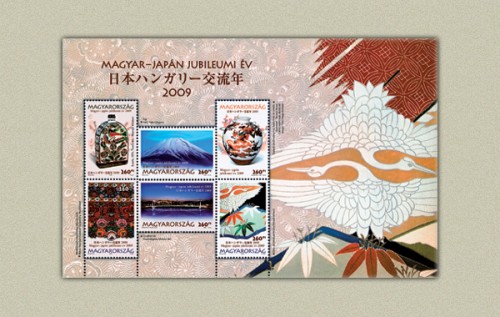
1. MAGYAR - MAGYAR-JAPÁN JUBILEUMI ÉV - KISÍV - Bélyeg rendelési kód: 2009 év bélyegei kompletten
2. ENGLISH - HUNGARY-JAPANESE JUBILEE YEAR - Order code of the stamp: 2009 Year stamps complete
3. GERMAN - UNGARISCH-JAPANISCHES JUBILÄUMSJAHR - Die Bestellnummer Der Marke: 2009 Jahr Briefmarken komplett
1. MAGYAR - MAGYAR-JAPÁN JUBILEUMI ÉV - KISÍV
Magyar-japán közös bélyeg kibocsátás.
Magyarország és Japán közös bélyeg kibocsátásával köszönti a két ország közötti diplomáciai kapcsolatfelvétel 140. és az újrafelvétel 50. évfordulóját.
Japán és Magyarország kapcsolata hivatalosan az Osztrák-Magyar Monarchia idején, 1869-ben vette kezdetét. Követséget azonban csak később, 1960-ban nyitott a két ország, amelyeket 1964-ben emeltek nagykövetségi rangra. A két állam közötti kapcsolat az 1989. évi magyarországi rendszerváltozást követően indult igazán fejlődésnek.
A magyar-japán jubileumi év kapcsán számos, a két ország hagyományos művészeteit bemutató rendezvény és zenei program várja az érdeklődőket. A változatos kulturális események egyik leglátványosabb momentuma, a két ország közötti barátság jelképeként valósul meg: Motoko Ishii művésznő tervei alapján a Dunát átívelő Erzsébet-híd díszkivilágítást kap. A jubileumi év köszöntéseként a Magyar Posta és a Japán Posta (Japan Post Service Co. Ltd.) együttműködésében közös bélyeg forgalomba bocsátására kerül sor.
A magyar-japán jubileumi év alkalmából megjelenő, hat bélyegképet tartalmazó magyar kisívben a bélyegképek egyedi, H betűt formázó perforációs elrendezésben helyezkednek el. A bélyegképeken a két ország nemzeti értékei közül ismerhető meg néhány, a magyar motívumok: butella (Néprajzi Múzeum, Budapest), matyó hímzés (Matyó Népi Iparművészeti Gyűjtemény, Mezőkövesd), díszkivilágított Erzsébet híd (Hajdú József fotója alapján, Motoko Ishii terve szerint); a japán motívumok: tealevél-tároló edény (Nemzeti Múzeum, Tokió), kimonó mintázat és a Fuji (Yukio Ohyama fotója alapján).
Az alkalmi boríték grafikáján a kisív keretrajza teljesedik ki, az alkalmi bélyegzőn pedig – a diplomáciai kapcsolatokra való utalással – egy író kéz látható.
Megjelenési időpont: 2009. október 16.
Forrás: Philatelia Hungarica Kft., Magyar Posta
2. ENGLISH - HUNGARIAN-JAPANESE JUBILEE YEAR
Hungarian-Japanese joint stamp issue
Hungary and Japan are celebrating the 140th anniversary of diplomatic relations and the 50th anniversary of the restoration of diplomatic relations between the two countries by a joint stamp issue.
Japanese-Hungarian relations officially began at the time of the Austro-Hungarian empire in 1869. Legations were only opened in the two countries later in 1960, which were raised to embassy status in 1964. Relations between the two countries, however, only gained real impetus after the change of political system in Hungary
in 1989.
In relation to the Hungarian-Japanese jubilee year there will be numerous events presenting the traditional arts and music of the two countries for those interested. One of the most impressive moments of the varied cultural programme will be realised as a symbol of the friendship between the two countries. Elizabeth Bridge over the Danube will be given new floodlighting designed by Ms Motoko Ishii. As part of the celebrations of the jubilee year Magyar Posta and Japan Post Service Co. Ltd. are making a joint stamp issue.
In the Hungarian miniature sheet containing six stamps appearing for the occasion of the Hungarian-Japanese jubilee year, the stamps are laid out in the shape of a perforated letter H. The stamp designs show a few of the national values of the two countries. The Hungarian designs are a flask from the Museum of Ethnography (Budapest), Matyo folk embroidery (Matyo Applied Art Folk Collection, Mezőkövesd) and the floodlit Elizabeth Bridge (based on a photo by József Hajdú and designed by Motoko Ishii).
The Japanese designs are a tea caddy from the Tokyo National Museum, a kimono pattern and Mount Fuji (based on a photo by Yukio Ohyama). On the graphics of the first day cover the design of the frame of the miniature sheet is completed, while the special postmark shows a writing hand, alluding to diplomatic relations.
Date of issue: 16 October 2009
3. GERMAN - UNGARISCH-JAPANISCHES JUBILÄUMSJAHR
Ausgabe einer ungarisch-japanischen gemeinsamen Briefmarke
Ungarn und Japan begehen das 140-jährige Jubiläum der Aufnahme und das 50. Jubiläum der Wiederaufnahme diplomatischer Beziehungen zwischen den beiden Ländern mit der Ausgabe einer gemeinsamen Briefmarke.
Offiziell begannen die Beziehungen zwischen Japan und Ungarn 1869, zurzeit der Österreich-Ungarischen Monarchie. Aber erst später, 1960 eröffneten die beiden Länder Gesandtschaften, die 1964 den Rang der Botschaft erhielten. Der politische Umschwung von 1989 in Ungarn trieb die Beziehungen zwischen den beiden Staaten richtig vorwärts.
Anlässlich des ungarisch-japanischen Jubiläumsjahrs erwarten die Interessenten viele Veranstaltungen und Musikprogramme, die die traditionellen Künste der beiden Länder präsentieren.
Einer der spektakulärsten Momente der vielfältigen kulturellen Ereignisse verwirklicht sich als Symbol der Freundschaft zwischen den beiden Ländern: die die Donau überspannende Elisabeth-Brücke bekommt eine Festbeleuchtung nach den Entwürfen der Künstlerin Motoko Ishii. Zu Ehren des Jubiläumsjahrs geben die Magyar Posta und die Japan Post Service Co. Ltd. eine gemeinsame Briefmarke aus.
Auf dem anlässlich des ungarisch-japanischen Jubiläumsjahrs erscheinenden, sechs Markenbilder enthaltenden ungarischen Kleinbogen sind die Briefmarkenbilder in individueller, den Großbuchstaben H formender Perforationsanordnung platziert worden.
Auf den Briefmarkenbildern sind einige von den nationalen Werten der beiden Länder abgebildet: die ungarischen Motive sind eine Bouteille (Volkskundemuseum, Budapest), eine Matyó-Stickerei (Matyó-Kunstgewerbe-Sammlung, Mezőkövesd) und die Festbeleuchtung der Elisabeth-Brücke (nach dem Foto von József Hajdú und dem Entwurf von Motoko Ishii); die japanischen Motive sind ein Teebehälter (Nationalmuseum, Tokio), ein Kimono-Muster und der Fuji (nach dem Foto von Yukio Ohyama).
Auf der Grafik des Sonderumschlags entfaltet sich die Rahmenzeichnung des Kleinbogens, auf dem Sonderstempel ist – hindeutend auf die diplomatischen Beziehungen – eine schreibende Hand zu sehen.
Erscheinungsdatum 16. oktober 2009










